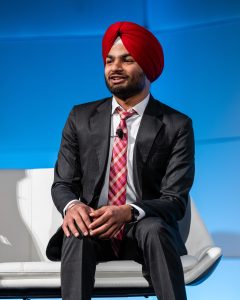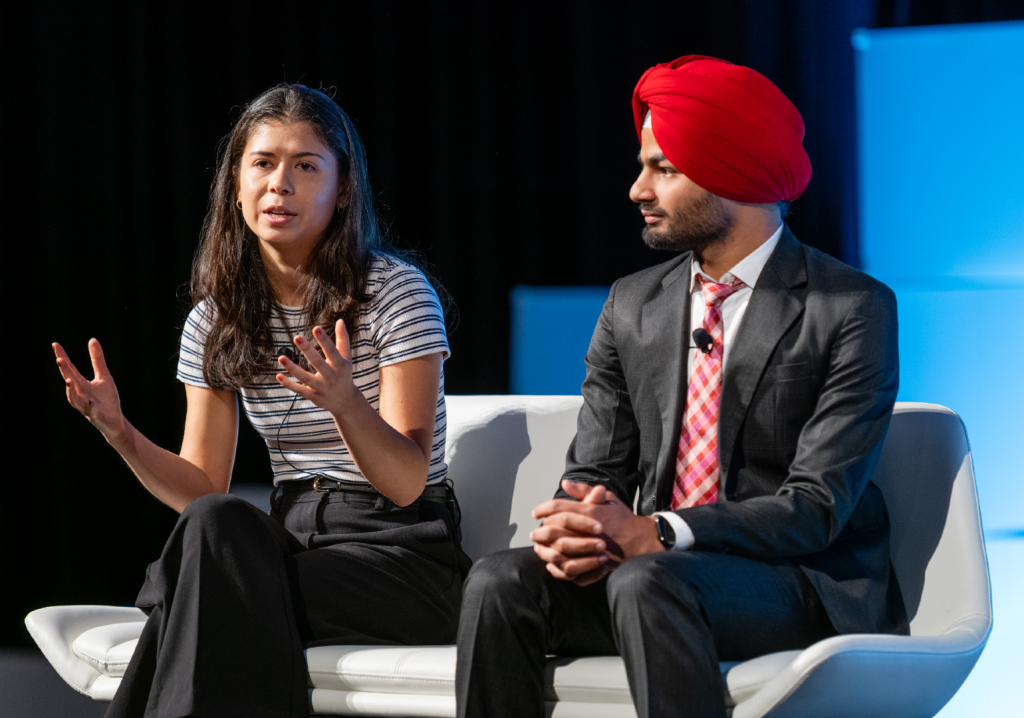On the second morning of Climate Smart Engineering (CSE23), a panel of talented young engineers shared their vision for a climate-resilient future — and how climate change has altered the course of their careers.
With the climate challenge set to dominate the professional careers of young engineers, attendees at CSE23 learned how this generation is harnessing its skills, ingenuity and voice to shape a greener and more sustainable tomorrow.
The panel included Simone Costello, Graduate Process Engineer (Water) at Arup; Sarbjeet Singh, Stormwater Engineer at City of Greater Geelong; Eve Smolinska, Project Engineer at Symal Infrastructure; and Mohamed Ishraf Mohamed Ismath, a Bachelor of Engineering (Honours) student at Swinburne University of Technology.
Costello first explained how climate change has altered her career pathway.
“When I was going through high school, there was evidence that climate change was coming, and that we were the generation that would be experiencing the effects of climate change — but also [that] we were responsible for tackling the challenge,” she explained.
“So that was definitely on my mind.”

Singh’s work for the City of Greater Geelong involves preparing residents and commercial players alike to deal with the future consequences of a changing climate.
The placement of wetland areas has been managed by the council to alleviate the impact of excess water caused by a major flooding event, he explained, forming part of an integrated flood management strategy.
“[Our] catchment contains a lot of residential, commercial and industrial development,” Singh said.
Time has passed since much of the local area’s infrastructure was implemented — therefore requiring upkeep that brings sustainability principles to the fore.
He said the City of Greater Geelong’s efforts boiled down to better preparing itself for large-scale disasters and alerting residents to the inevitability of such events in the future.
“It’s entirely up to [young engineers] to be prepared for the consequences of climate change … on our cities.”
Smolinska noted certain areas where innovation in climate management is already front and centre.
“The biggest area I see … in the construction industry is the reuse of waste,” she said. “There’s lots of materials such as recycled plastics [and] recycled glass [being used].
“But recently there’s been a huge innovation happening [with the use of] recycled crushed concrete to produce new concrete … This is a huge opportunity to reduce the captured carbon and use a new material … in construction projects.”
A recent trial organised by Rail Projects Victoria, for example, shows a commitment to investigating alternatives to concrete.
The trial engaged three different suppliers, each given “space to experiment” to develop a sustainable concrete mix.
The next step is to get the Australian standard revised — which is a key barrier to progress, Smolinska admitted.
Ismath added that electric vehicles is a space in which there is much potential for positive growth in a sustainable direction.
The use of rechargeable lithium ion batteries, for instance, is “one of the best options” for environmentally friendly transportation.
Changing the discourse
Ultimately, the panellists agreed that the conversation around, and facilitating of, action on climate change need to change.
Costello suggested that engineers need to start up conversations with everyone, particularly non-engineers, to more effectively communicate its virtues to a wider audience.
For Singh, it often comes down to funding.
“[Working for] local governments … the biggest problem is that we can’t innovate,” he said. “Funding is rare for us. When we get it, we basically can’t spend it on something [with experimental] thinking.”
Engineers within governments, he said, need to make sure they are using the public’s money wisely before taking action.
The discussion then turned to the panellists’ varied experiences studying engineering.
“I went to an all-girls school, and in my grade I was the only one to study engineering,” she said. “That’s quite shocking. We need to improve in that area. We need to encourage more girls particularly to [study] STEM.
“It wasn’t really encouraged as an option. When we were doing science back in school, it didn’t focus on the engineering part … We can make it more exciting.
By contrast, Singh noted that in his home country of India, “everyone wants to do it” — it’s being accepted into an engineering degree that’s a challenge.
“In Poland,” Smolinska added, “it’s normal for women to go into STEM … the split is probably 50/50.
“It doesn’t have as much stigma.”
The session’s biggest takeaway?
“We need to challenge the status quo,” Costello concluded.
Engineers Australia acknowledges the support of the Victorian State Government and Melbourne Convention Bureau in helping make this event happen.
The Climate Smart Engineering conference will return in 2024.
